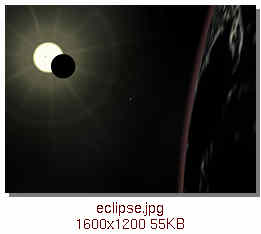Some Celestia Experiences
![[ISS Closeup]](iss-closeup-01.jpeg)
ISS Closeup |
![[ISS full view]](iss-panels-a.jpeg)
ISS full view |
![[Solar panel closeup]](iss-panel-close.jpeg)
Solar panel closeup |
![[Ida seen from Dactyl]](ida-from-dactyl.jpeg)
Ida seen from Dactyl |
| . | . | . | ||
| Venus | . | . | ||
|---|---|---|---|---|
![[Venus Transits Jupiter in 1818]](vtj1.jpeg)
Venus Transits Jupiter in 1818 |
As it might have been seen from over Hawaii. | |||
![[Venus Occults Mercury in 1737]](vtm1.jpeg)
Venus Occults Mercury in 1737 |
On May 28, 1737, John Bevis observed portions of the passage of Venus in
front of Mercury from Greenwitch Observatory.
Here's Celestia's image of that event, as viewed (roughly) from the location of Greenwitch. A small piece of Mercury is visible past the lower left edge of Venus. Since Celestia does not implement light travel time, the time and appearance of this event is distorted. Mercury is about 1 AU away (8.3 light minutes) while Venus is only about 1/3 of an AU away (less than 3 light minutes). |
. | ||
| . | . | . | ||
| Mars | . | . | ||
![[Mars Transits Saturn in 9BC]](mts4.jpeg)
Mars Transits Saturn in 9 BC |
Telescopic view as seen from above the FingerLakes of NY. It happened during the day and near the sun, so nobody would have seen it even if they'd had telescopes way back then. |
|||
![[Mars Transits Jupiter in 1170]](mtjc.jpeg)
Mars Transits Jupiter in 1170 Mars Transits Jupiter in 1170 (closeup) |
Gervase of Canterbury observed Mars transiting Jupiter on the night of Sepember 12th, 1170. Here's Celestia's view of this event as seen from above England. | |||
|
Celestia v1.3.0pre3 bug
Cel:// URL:
|
The "OpenGL Vertex Program" does not illuminate objects. | Although "Ambient Light" level is set to "Medium", Mars is shown as if it were set to "None". | See the image "Mars-4" below. | |
|
|
|
|
|
|
![[Render path: Basic]](mars-1.jpeg)
Render path: Basic |
![[Render path: Multitexture]](mars-2.jpeg)
Render path: Multitexture |
![[Render path: NVIDIA Combiners]](mars-3.jpeg)
Render path: NVIDIA Combiners |
![[Render path: OpenGL Vertex Program]](mars-4.jpeg)
Render path: OpenGL Vertex Program |
![[Render path: OpenGL Vertex Program/NVIDIA Combiners]](mars-5.jpeg)
Render path: OpenGL Vertex Program/NVIDIA Combiners |
| Jupiter | . | . | ||
![[Jupiter Occults Neptune in 1613]](jon1.jpeg)
Jupiter Occults Neptune in 1613 |
This happened during the time Galileo was observing Jupiter, but while Jupiter was out of sight of Italy. Apparently he noted Neptune as a star. | |||
| . | . | . | ||
| Saturn | ||||
![[Saturn's rings casting shadows]](saturn-ringshadows.jpeg)
Saturn's rings casting shadows |
A graphics card with OpenGL v1.4 is needed for ring shadows
to be visible on the image of the planet.
Cards known to work include Nvidia GeForce3 and GeForce4 cards with v40 or later drivers. |
![[Titan and Saturn's ring shadows]](titan.jpeg)
Titan and Saturn's ring shadows | ||

Saturn near Earth's solar eclipse on June 11, 2002. Saturn is the bright dot in the center of the picture. |
![[Saturn's new rings]](saturn-rings.jpeg)
Pan in Enke's Gap Saturn is off screen to the right. |
|||
![[Seeing Barnard 33 past Pan]](b33pan.jpeg)
Pan, Orion, and the Horsehead Nebula (Barnard 33) |
This view requires the Horsehead Nebula addon.
See billboard.html#5.4 Pan and Nebula URLs:
Pan and Orion
Barnard 33 is also known as the Horsehead Nebula. |
|||
![[Saturn by Cassini #1]](pia02884.jpeg)
Saturn by Cassini #1 |
![[Saturn by Celestia]](saturn-by-celestia.jpeg)
Saturn by Celestia |
|||
|
October 21, 2002, 285 million km from Saturn.
According to the article, the only moon resolved was Titan. They enhanced its brightness 3x compared to Saturn. |
October 21, 2002, 285 million km from Saturn.
Credit: Celestia by Chris Laurel Telescopic screen snapshot taken from the viewpoint of Cassini's xyz position at 2002 10 21 15:54:37 UTC. Note that several moons are visible in addition to Titan. |
|||
![[Colorful Threads]](images/pia06114.jpeg)
Colorful Threads (by Cassini) |
![[Colorful Threads (by Celestia)]](images/cassini-saturn.jpeg)
Colorful Threads (by Celestia) |
|||
|
July 30, 2004, 7.6 million km from Saturn.
|
July 30, 2004, 7.4 million km from Saturn.
|